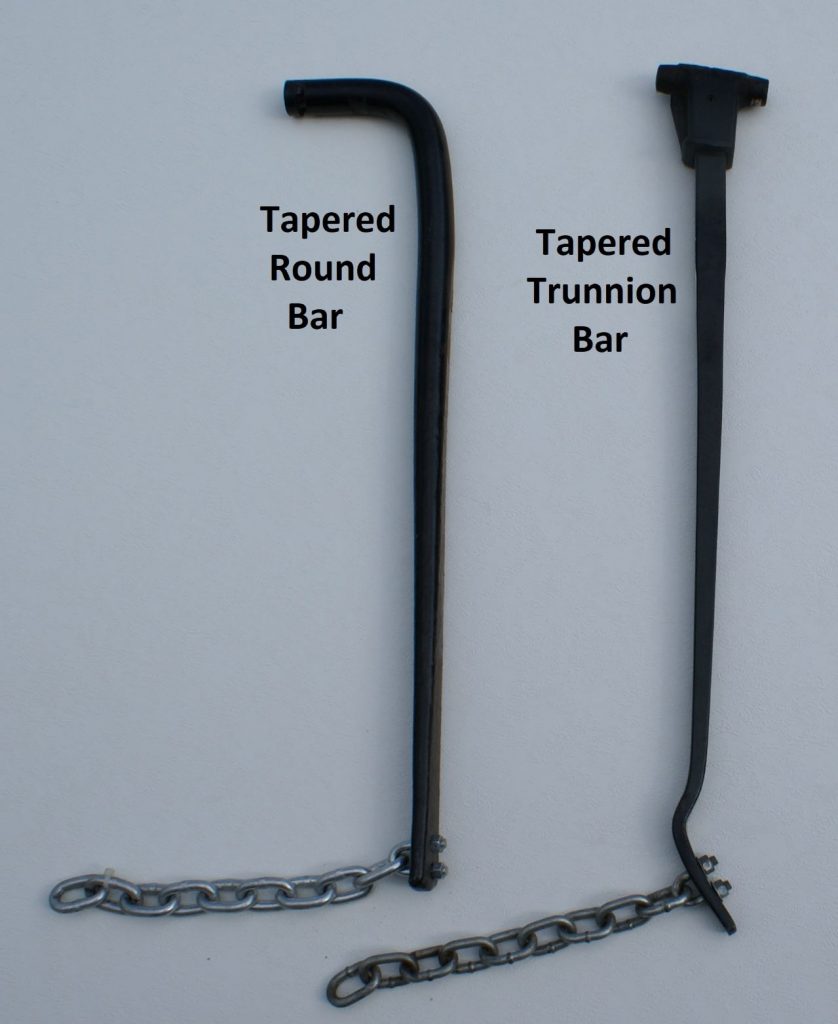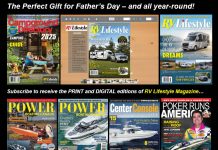Here’s how we select the correct equalizer bars for each rig …
When setting up most RV combinations with weight distribution hitches, when you adjust the pressure on the weight distribution hitch you want the tow vehicle to be pushed straight down. If the trailer pushes the back of the tow vehicle down one-half inch, you want the front of the tow vehicle to be pushed down one-half inch as well. That is why the weight distribution hitch is often called an equalizing hitch – it equalizes the down pressure on the front and rear axles of the tow vehicle. We have articles that detail the procedure if you would like one just send me an email.
Torsion bars usually have a weight rating on a label or stamped on them. The various types of bars that we see these days usually have a rating that ranges between 600 and 1,200 pounds. People often assume that if the trailer has a 600-pound hitch weight, that is the rating for the torsion bars you need. As usual, the answer is not quite that simple. For one thing, you really can’t use the brochure tongue weight of the trailer as a guide. In most cases it won’t include the weight of the battery or propane tanks, and if it does include the tanks, they may have been weighed empty, or full, or anywhere in between. If there is a huge front storage compartment you are likely to add some weight there as well… a trailer with a listed hitch weight of 500 pounds could easily be 700 pounds when loaded for travel. To further complicate the process, that is only the case if the weight in the brochure is accurate – often it is a ‘best guess’. Grand Design RV is the only company I know of that gives you the actual hitch weight of each of their trailers.
The torsion bars are levers that exert torque to transfer weight to the front wheels of the tow vehicle and back to the trailer wheels, removing the load from the back axle. You can measure the amount of torque necessary by measuring the distance from the hitch ball to the front and rear axles of the tow vehicle and calculating the amount of weight to transfer.
If the tow vehicle is long – for example a pickup truck with an 8-foot box, the weight has to be transferred much farther than has to be transferred on a shorter vehicle. Therefore, you need higher torsion bar rating to accomplish the same weight transfer. To give this an actual example, our Tesla Model 3 has a wheelbase of 113” and an overhang of 40” from the rear axle to the hitch ball. The Airstream we tow most often with the Tesla has a hitch weight of 620 pounds. We use 800-pound torsion bars to transfer this hitch weight quite nicely, and the setup gives us amazing handling and a nice controlled ride. Part of this is due to the firm shock dampening on the Tesla and its hyper low centre of gravity.
If I connect the same trailer to our Ram 1500 Crew Cab with 149” wheelbase and 56” rear overhang I would need 1000-pound bars to transfer the weight, however In this case I would use 1200-pound bars… although the 1000-pound bars would transfer the weight, there would barely be any weight distribution capacity to spare, and the truck would tend to ride with a front-to-rear pitch because the torsion bars would be at their maximum limit.
Another factor to be considered when setting up your weight distributing hitch is the trailer suspension and its centre of gravity. Typical trailers have a leaf spring suspension with a pivoting arm between the springs. This arm assures that the front and rear axle weights are always equal. This is good from a tire loading perspective, and it allows you to run the trailer a little lower at the front, which helps reduce the aerodynamic drag a little. The downside of the leaf spring with pivoting arm suspension is that there is no resistance to front-to-rear pitch. On a torsion axle, which is independent suspension, there is a resistance to front-to-rear movement because the front rear axles are only equal in the weight they carry when the trailer is level.

The other issue is a matter that is very difficult to determine – are all brands of 600-pound bars equal? Most of the setups we do use a tapered round bar. We like this type of bar because it has a large range of motion, so it is easier on the hitch receiver and the trailer A-frame when you drive through dips in the road. This setup does not always lend itself to the trailer/tow vehicle combination. Once the ball height is below 18” these bars require too much ground clearance, so we use a tapered trunnion style bar instead. The 600-pound trunnion bar acts more like an 800-pound round bar on the highway, but it tightens up more quickly in dips.
On some vehicles, you may have trouble getting the equalizing hitch and torsion bars to push down the front axle on the tow vehicle, so you get heavier bars, put them on the end link, and the front is still too high, maybe up a half-inch from the solo position… so you tighten the bars another link, take the measurement, and again it is still up a half-inch – nothing changed. If this is the case, you then have a receiver problem. The receiver is just twisting instead of transferring weight. Some receivers will not transfer the weight they are rated for, largely due to the vagueness of the Society of Automotive Engineers (SAE) standard that some hitch components some are built to. If this is the case, then the receiver should be reinforced so that it can transfer enough weight. If the trailer happens to have an excessively high hitch weight (over 15% of the total trailer weight) then there are sometimes things you can do to reduce the hitch weight to something the receiver can handle. You have to be careful though – if the hitch weight is too low the handling characteristics of the trailer could be unstable.
I wish I could give you a hard and fast rule on which bars to use, but even with all the thousands of setups we do we sometimes get it wrong. We will set up a combo – say a Tahoe with a trailer that has 750-pound hitch weight. We’ll look at it and say 1,000-pound bars should work out well. Then, on the test drive, we might realize that 1,200-pound bars would better, so we wheel it back into the shop and change the bars, then head back to road test the rig.
The bottom line to solving the mystery of torsion bars for your equalizing hitch is that every combination is a little different. You have to rely on the experience and expertise of your RV dealer’s hitch installation team to properly match your trailer to your tow vehicle and set up the combination for optimum towing and road handling performance. When you get the rig tuned just right, you will notice a substantial enhancement to the towing characteristics, and you will enjoy a relaxed road trip experience.






















